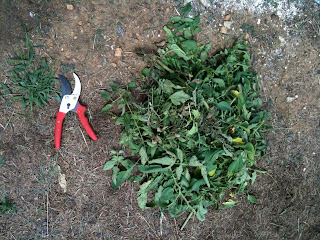Well, nature must have heard my thoughts and wanted to clear up what it really means for gardening to be a humbling experience because it seems to be using every trick in the book to make sure I understand this summer.
I wrote a few weeks ago about a rapidly progressing mildew problem I was having with my cucumber plants and how I'd cut them back to try and control it. The spores had really gotten out of hand as can be seen in this black fuzz all over the cucumber vine below.
Here are photos of the cuts I made (left) and their current state (right).
The leaves all grew back but the mildew continues to make them yellow. They are actually doing better now and growing like crazy. The organic fungicide I'd purchased proved useless, so I decided to go with an old home remedy: a weekly spray of 9 parts water to 1 part skim milk with a couple teaspoons of cooking oil thrown in for stickiness. So far it seems to be keeping things under control. Most importantly, the cucumber yield is back up. Below is what I was able to pick just yesterday.
As this problem seemed to be reaching a more manageable state, the lovely squash borer came into my life. These are fun little larvae that settle right in to the interior of squash plant vines and make this happen:
The first clue is a wilted plant (left) and, upon further inspection, one may find a rotten vine (right). Cutting into your squash vine will likely reveal one of these little friends all tucked away nice and cozy and gorged on your delicious squash vine.
Additionally, you may find deserted brown casings from the pupal stage lurking around the base of your plants. Once the borers have moved in, you're kind of screwed. The squash plants have likely already started dying and may have even stopped producing. However, there were a few areas of new growth lurking on my plants so I cut the good parts off and stuck the ends of the vines back in the ground hoping they might take root for a few more rounds of squash. It worked for a couple of the plants, but not all of them.
Another line of defense I am trying against the squash borers and other types of aphids which like to help themselves to delicious garden snacks is diatomaceous earth. So far it seems to be helping. I've sprinkled it everywhere once a week and more frequently if it rains.
This stuff is also great for controlling ants in compost, which is what I usually use it for. It just comes in a huge bag, so I use an old coffee can with holes poked in the lid for dusting.
I haven't had any trouble with worms eating my tomatoes except for this one below which I quickly squashed.
I also found these weird eggs and little critters just starting to come to life on the underside of a tomato leaf one day, but they were promptly executed and I haven't seen any others since.
Coupled with my weekly milk spray and diatomaceous earth dusting is removal of infected leaves from tomato plants. Most of my plants are still showing leaf spot on the bottom leaves, but I've been able to keep it in check by taking time every couple of days to cut off the infected areas so it doesn't spread.
While nature is definitely showing me who is boss this year, I'm learning a lot and keeping copious notes in my garden journal for the future. Despite everything that is testing me, I'm still having lots of success which I will share soon.





















































